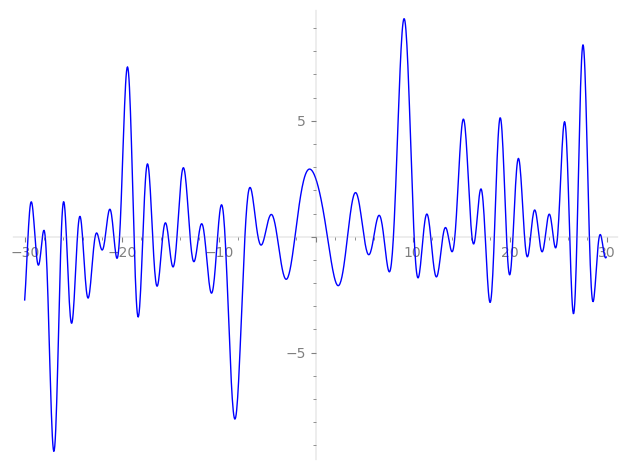| L(s) = 1 | + (2.81 − 0.288i)2-s + (−3.93 + 3.39i)3-s + (7.83 − 1.62i)4-s + 5·5-s + (−10.0 + 10.6i)6-s + 20.9i·7-s + (21.5 − 6.83i)8-s + (3.93 − 26.7i)9-s + (14.0 − 1.44i)10-s + 46.5i·11-s + (−25.2 + 32.9i)12-s + 14.8i·13-s + (6.03 + 58.8i)14-s + (−19.6 + 16.9i)15-s + (58.7 − 25.4i)16-s + 19.4i·17-s + ⋯ |
| L(s) = 1 | + (0.994 − 0.102i)2-s + (−0.756 + 0.653i)3-s + (0.979 − 0.203i)4-s + 0.447·5-s + (−0.686 + 0.727i)6-s + 1.12i·7-s + (0.953 − 0.301i)8-s + (0.145 − 0.989i)9-s + (0.444 − 0.0456i)10-s + 1.27i·11-s + (−0.608 + 0.793i)12-s + 0.315i·13-s + (0.115 + 1.12i)14-s + (−0.338 + 0.292i)15-s + (0.917 − 0.397i)16-s + 0.277i·17-s + ⋯ |
\[\begin{aligned}\Lambda(s)=\mathstrut & 120 ^{s/2} \, \Gamma_{\C}(s) \, L(s)\cr =\mathstrut & (0.524 - 0.851i)\, \overline{\Lambda}(4-s) \end{aligned}\]
\[\begin{aligned}\Lambda(s)=\mathstrut & 120 ^{s/2} \, \Gamma_{\C}(s+3/2) \, L(s)\cr =\mathstrut & (0.524 - 0.851i)\, \overline{\Lambda}(1-s) \end{aligned}\]
Particular Values
| \(L(2)\) |
\(\approx\) |
\(2.19347 + 1.22553i\) |
| \(L(\frac12)\) |
\(\approx\) |
\(2.19347 + 1.22553i\) |
| \(L(\frac{5}{2})\) |
|
not available |
| \(L(1)\) |
|
not available |
\(L(s) = \displaystyle \prod_{p} F_p(p^{-s})^{-1} \)
| $p$ | $F_p(T)$ |
|---|
| bad | 2 | \( 1 + (-2.81 + 0.288i)T \) |
| 3 | \( 1 + (3.93 - 3.39i)T \) |
| 5 | \( 1 - 5T \) |
| good | 7 | \( 1 - 20.9iT - 343T^{2} \) |
| 11 | \( 1 - 46.5iT - 1.33e3T^{2} \) |
| 13 | \( 1 - 14.8iT - 2.19e3T^{2} \) |
| 17 | \( 1 - 19.4iT - 4.91e3T^{2} \) |
| 19 | \( 1 - 120.T + 6.85e3T^{2} \) |
| 23 | \( 1 + 89.5T + 1.21e4T^{2} \) |
| 29 | \( 1 + 150.T + 2.43e4T^{2} \) |
| 31 | \( 1 + 332. iT - 2.97e4T^{2} \) |
| 37 | \( 1 + 119. iT - 5.06e4T^{2} \) |
| 41 | \( 1 + 516. iT - 6.89e4T^{2} \) |
| 43 | \( 1 - 35.5T + 7.95e4T^{2} \) |
| 47 | \( 1 + 288.T + 1.03e5T^{2} \) |
| 53 | \( 1 - 249.T + 1.48e5T^{2} \) |
| 59 | \( 1 - 9.27iT - 2.05e5T^{2} \) |
| 61 | \( 1 - 184. iT - 2.26e5T^{2} \) |
| 67 | \( 1 - 822.T + 3.00e5T^{2} \) |
| 71 | \( 1 + 578.T + 3.57e5T^{2} \) |
| 73 | \( 1 + 381.T + 3.89e5T^{2} \) |
| 79 | \( 1 - 991. iT - 4.93e5T^{2} \) |
| 83 | \( 1 + 227. iT - 5.71e5T^{2} \) |
| 89 | \( 1 + 401. iT - 7.04e5T^{2} \) |
| 97 | \( 1 - 1.45e3T + 9.12e5T^{2} \) |
| show more | |
| show less | |
\(L(s) = \displaystyle\prod_p \ \prod_{j=1}^{2} (1 - \alpha_{j,p}\, p^{-s})^{-1}\)
Imaginary part of the first few zeros on the critical line
−12.95038772488937709639718450543, −12.07899959033017793840070505808, −11.45680079162665083588925168996, −10.11637300645375839518068405070, −9.346531383003203898791074017019, −7.30062875442336548284245946577, −5.94834259230417542854348480549, −5.27597697076698885180309442805, −3.97108093026772291121951142167, −2.13922622622229937224526090239,
1.20445877369402169671128790541, 3.27683684642965989501232143415, 4.97867791843575410472327157249, 5.98532419715504931981492118476, 7.01663508236824225510609478572, 8.009095359620892401605389476686, 10.14499881224037617533521655371, 11.06998878541614397535215205314, 11.85400406280198940038660382993, 13.10188566878809242397567589722

